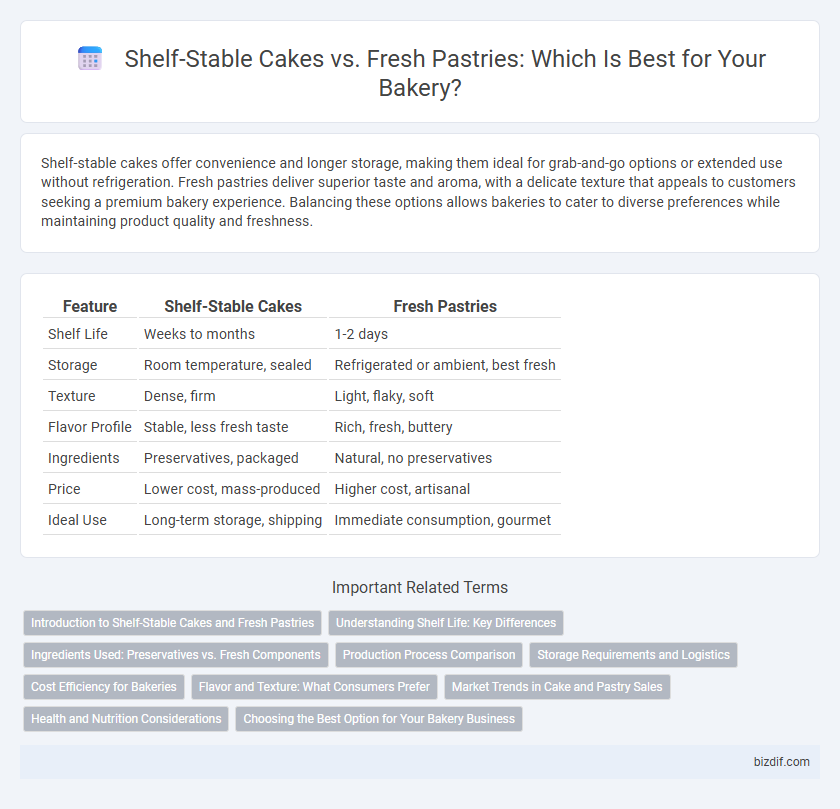Shelf-stable cakes offer convenience and longer storage, making them ideal for grab-and-go options or extended use without refrigeration. Fresh pastries deliver superior taste and aroma, with a delicate texture that appeals to customers seeking a premium bakery experience. Balancing these options allows bakeries to cater to diverse preferences while maintaining product quality and freshness.
Table of Comparison
| Feature | Shelf-Stable Cakes | Fresh Pastries |
|---|---|---|
| Shelf Life | Weeks to months | 1-2 days |
| Storage | Room temperature, sealed | Refrigerated or ambient, best fresh |
| Texture | Dense, firm | Light, flaky, soft |
| Flavor Profile | Stable, less fresh taste | Rich, fresh, buttery |
| Ingredients | Preservatives, packaged | Natural, no preservatives |
| Price | Lower cost, mass-produced | Higher cost, artisanal |
| Ideal Use | Long-term storage, shipping | Immediate consumption, gourmet |
Introduction to Shelf-Stable Cakes and Fresh Pastries
Shelf-stable cakes are designed with preservatives and packaging techniques that extend their shelf life without refrigeration, making them ideal for long-term storage and distribution. Fresh pastries, in contrast, rely on immediate consumption or short-term refrigeration to maintain their delicate texture, flavor, and freshness. Understanding the differences in ingredients and storage requirements helps bakeries optimize product quality and meet customer preferences.
Understanding Shelf Life: Key Differences
Shelf-stable cakes are specially formulated with preservatives and moisture barriers to maintain quality for weeks or months without refrigeration, making them ideal for extended storage and shipping. Fresh pastries, in contrast, rely on their high moisture content and lack of preservatives, resulting in a shorter shelf life of one to three days, ensuring optimal taste and texture only when consumed promptly. Understanding these key differences in shelf life helps bakers and consumers select products based on storage needs and freshness preferences.
Ingredients Used: Preservatives vs. Fresh Components
Shelf-stable cakes commonly contain preservatives such as sorbic acid and potassium sorbate to extend their shelf life by inhibiting mold and bacterial growth. Fresh pastries prioritize natural, high-quality ingredients like fresh butter, eggs, and cream without synthetic additives, enhancing flavor and texture but limiting storage duration. The choice between preservatives and fresh components directly impacts product freshness, taste, and consumer preferences in bakery offerings.
Production Process Comparison
Shelf-stable cakes undergo extensive baking, moisture reduction, and chemical preservation to extend their shelf life up to several months without refrigeration, whereas fresh pastries are produced with minimal preservatives and rely on quick turnover to maintain freshness. The production of shelf-stable cakes involves high-temperature baking followed by packaging in airtight containers to inhibit microbial growth, contrasting with fresh pastries that emphasize delicate dough handling and immediate selling within days. This fundamental difference in production processes significantly impacts texture, flavor retention, and storage requirements between the two bakery products.
Storage Requirements and Logistics
Shelf-stable cakes are formulated with preservatives and packaging designed to maintain freshness without refrigeration, enabling easier transportation and extended shelf life up to several weeks. Fresh pastries require strict temperature control, typically refrigeration or freezing, to preserve texture and flavor, demanding more sophisticated logistics and shorter delivery windows. Proper storage conditions directly impact supply chain efficiency and product quality in bakery distribution.
Cost Efficiency for Bakeries
Shelf-stable cakes offer greater cost efficiency for bakeries by reducing waste through extended shelf life and minimizing the need for daily production. Fresh pastries, while appealing for quality and taste, often incur higher costs due to shorter freshness windows and increased labor for frequent baking. Implementing shelf-stable options enables bakeries to optimize inventory management and lower operational expenses without compromising product availability.
Flavor and Texture: What Consumers Prefer
Shelf-stable cakes often prioritize convenience and longer shelf life, but their flavor and texture tend to be less appealing compared to fresh pastries. Consumers generally prefer the rich, flaky texture and aromatic freshness of pastries made daily, which deliver superior taste and mouthfeel. Fresh pastries' delicate crumb and buttery notes create a more satisfying eating experience, driving higher customer satisfaction and repeat purchases.
Market Trends in Cake and Pastry Sales
Shelf-stable cakes leverage advanced preservation techniques, extending product shelf life and expanding market reach through online and retail distribution channels. Fresh pastries maintain dominance in artisan bakery segments where consumers prioritize taste and quality, fueling local bakery sales and premium pricing strategies. Market trends reveal a growing demand for convenience-driven shelf-stable options alongside a consistent preference for freshly baked goods in specialty and high-end markets.
Health and Nutrition Considerations
Shelf-stable cakes often contain preservatives and higher sugar levels to extend their shelf life, which may impact nutritional value compared to fresh pastries. Fresh pastries typically offer better texture and flavor with fewer additives, supporting a more wholesome diet when consumed promptly. Choosing fresh pastries can provide essential nutrients with less processed ingredients, promoting overall health benefits.
Choosing the Best Option for Your Bakery Business
Shelf-stable cakes offer extended shelf life through preservatives and airtight packaging, reducing waste and enabling wider distribution, making them ideal for long-term inventory management in bakery businesses. Fresh pastries prioritize artisanal quality and taste, attracting customers seeking premium, handcrafted products and encouraging repeat visits due to limited availability. Selecting the best option depends on your target market, operational capacity, and sales strategy, balancing product longevity with freshness to maximize profitability and customer satisfaction.
Shelf-stable cakes vs Fresh pastries Infographic

 bizdif.com
bizdif.com